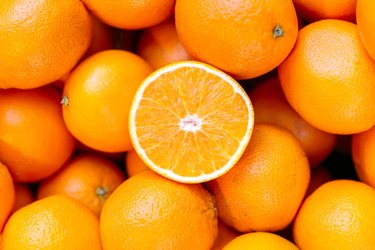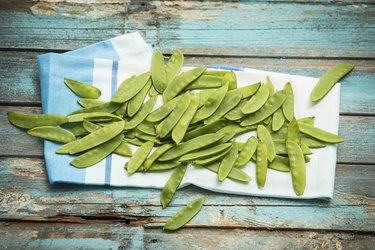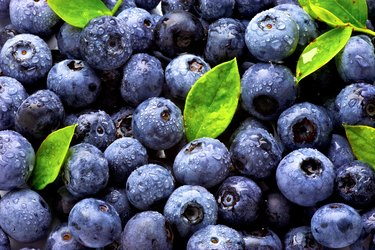Perhaps most famous for its antioxidant properties, vitamin C — also called ascorbic acid — is a water-soluble vitamin that supports immune health, helps produce collagen and helps the body absorb iron, according to the National Institutes of Health (NIH).
Foods high in vitamin C are generally fruits and veggies.
Video of the Day
Vitamin C deficiency is rare these days, but in the 18th century when sailors embarked on months-long overseas journeys without access to fresh fruits and vegetables, they often developed scurvy, a disease that occurs from severe lack of vitamin C, per the U.S. National Library of Medicine (NLM). Symptoms of scurvy include anemia, gum disease, weakness and skin hemorrhages.
How Much Vitamin C Do You Need?
Adults assigned female at birth need 75 milligrams of vitamin C per day while adults assigned male at birth need 90 milligrams per day, according to NIH.
Video of the Day
Check out the vitamin C foods list below. Note that the FDA calculates its Daily Value (DV) percentages based on eating 90 milligrams of vitamin C per day.
1. Guava: 419% Daily Value (DV)

This bright tropical fruit is the top food high in ascorbic acid, offering 376.7 mg or 419 percent (!) of the DV as well as 9 grams of fiber and 4 grams of protein per 1-cup serving. Blend it into your favorite smoothie for a refreshing, hydrating and vitamin C-rich snack.
2. Red Bell Peppers: 211% DV
Bell peppers of all colors are excellent sources of vitamin C, but red contains the most, with 190.3 mg or 211 percent of the DV per 1 cup raw. Red bell peppers also contain much higher levels of beta-carotene (that's why they're red!) than their green and yellow sisters.
This vitamin C vegetable also contains fiber and a bit of plant-based iron (also called non-heme iron).
Tip
To get the most vitamin C out of your veggies, eat them raw. Heat can destroy vitamin C, so cooking your veggies may not be the best way to get the nutrient, per the Harvard T.H. Chan School of Public Health.
3. Kiwi: 185% DV
Kiwifruit hails from New Zealand, and its sweet green flesh delivers 166.9 mg or 185 percent of the DV for vitamin C per cup (that's about two whole fruits).
This vitamin C fruit is also a good source of fiber and provides some potassium and phosphorous. Cut your kiwi in half and use a spoon to scoop out the fruit from its own bowl.
4. Green Bell Pepper: 133% DV
While green bell peppers don't contain quite as much vitamin C as red bell peppers, just 1 cup will get you well over your daily needs with 119.8 mg or 133 percent of the DV.
And like their red sister, green bell peppers provide some iron and fiber, making them a nutritious add-in to salads and stir-fries.
5. Broccoli: 112% DV
A 1-cup serving of cooked broccoli contains 101.2 mg or 112 percent of the DV for vitamin C, 5 grams of fiber and nearly 4 grams of protein.
Broccoli is also an excellent source of fat-soluble vitamin K. That means cooking the vegetable in a bit of butter tastes great and helps your body absorb the vitamin K.
6. Strawberries: 108% DV
Yes, strawberries (the only fruit to wear its seeds on the outside, by the way) rank higher than oranges in the vitamin C department. (But don't worry, we'll get to oranges soon.)
A 1-cup serving of this summer favorite delivers 97.6 mg or 108 percent of the DV for vitamin C and 3 grams of fiber. Try them in these delicious strawberry breakfast recipes.
Related Reading
7. Brussels Sprouts: 107% DV
You either love 'em or hate 'em, but there's no question that Brussels sprouts are super nutritious. They're higher in vitamin C than oranges, with 96.7 mg or 107 percent of the DV per cup cooked and have fiber and plant-based protein.
While roasting the sprouts makes for a fan favorite, you'll want to try these creative Brussels sprouts recipes, too.
8. Oranges: 106% DV

Orange you glad we finally got to oranges? While oranges and orange juice are the poster children for vitamin C, as you've read, they have much lower amounts than other fruits and vegetables. But 1 cup will still clock in at more than your daily needs: 95.8 mg or 106 percent of the DV for vitamin C.
Orange juice is often fortified with important nutrients, including calcium and vitamin D, making it a healthy part of your diet in moderation, as it still contains high sugar levels.
9. Papaya: 98% DV
A cup of this pink-red fruit delivers almost a full day's worth of vitamin C, with 88.3 mg or 95 percent of the DV.
Thanks to its red color, the tropical fruit is also a good source of vitamin A and lycopene, which is a powerful antioxidant found in red foods (like tomatoes) that has been linked to lower stroke risk, according to the American Heart Association (AHA).
10. Grapefruit: 95% DV
Grapefruit, orange's more tart cousin, offers comparable nutrition. (But no, it does not boast enough nutrition for you to safely follow the notorious grapefruit fad diet for weight loss.)
A 1-cup serving offers 85.1 mg or 95 percent of the DV for vitamin C, making it a tasty alternative to oranges for when you want to switch up your citrus fruits. The pink and red varieties are good sources of beta-carotene, which is needed to make vitamin A, as well as lycopene, according to the AHA.
Warning
Grapefruit has been shown to interfere with some anti-cholesterol statin drugs and other heart-related medications, per the AHA. If you take these types of medications, speak with your doctor about whether you should include grapefruit in your diet.
11. Pineapple: 88% DV
Pineapple, another tropical fruit, touts sweetness and high amounts of vitamin C: 78.9 mg or 88 percent of the DV per cup.
Pineapple can be cut into chunks, sliced into spears rings and offers a deliicous smoky-sweet taste when grilled.
12. Mango: 67% DV
Ripe mango is sweet, juicy and creamy, but it's also one of the higher-sugar fruits, with 45 percent of the DV for sugar per 1-cup serving. That said, it offers many other nutrients, making it a healthy option.
Per 1-cup serving, mango has 60.1 mg or 67 percent of the DV for vitamin C. It also has smaller amounts of potassium and vitamins A, E and K.
13. Cantaloupe Melon: 65% DV

If you're looking for ways to get more vitamin C, fruit really is the way to go. Cantaloupe melon is hydrating thanks to its water content and provides 58.7 mg or 65 percent of the DV for vitamin C per 1-cup serving.
Cantaloupe, like other melons including watermelon, also contain vitamin A, vitamin B6, potassium and fiber, according to the USDA.
14. Cauliflower: 61% DV
Another cruciferous vegetable, like Brussels sprouts and broccoli, cauliflower is an excellent source of vitamin C, with 54.9 mg or 61 percent of the DV per 1 cup cooked.
Cauliflower, which comes in several varieties, including white, purple, green and Romanesco, offers fiber and vitamin K. Try cooking the low-calorie veggie with one of these comforting cauliflower recipes (but remember, cooking can reduce the vitamin C content).
15. Tomatoes: 61% DV
Tomatoes, cooked or raw, are a good source of many nutrients, including the antioxidant lycopene. Cooked tomatoes, though, are higher in vitamin C than raw tomatoes, with 54.7 mg or 61 percent of the DV versus 23 percent per cup.
It's worth noting, however, that cooking vegetables tends to decrease its vitamin C levels, according to an April 2018 study in Food Science and Biotechnology.
16. Tangerines: 58% DV
Orange's little sister, the tangerine, is the perfect snack: The one-bite slices are juicy and sweet, and a 1-cup serving packs 52.1 mg or 58 percent of the DV for vitamin C.
Tangerines also provide some calcium, potassium and iron. Add sliced tangerines to yogurt or oatmeal for natural sweetness and fiber.
17. Sweet Potatoes: 44% DV
If you're looking for a more hearty source of vitamin C than citrus fruits or cruciferous vegetables, look to sweet potatoes. A 1-cup serving of baked sweet potato (may we recommend a dash of cinnamon and a drizzle of maple syrup on top?) contains 39.2 mg or 44 percent of the DV for vitamin C.
Sweet potatoes are high in beta-carotene — hence their orange color — and have nearly 7 grams of fiber per cup.
18. Snow Peas: 42% DV

Peas come in a variety of shapes, sizes and colors. The flat snow pea pod contains very small peas, and once you remove the strings from the pod, you can eat the entire thing. Like most peas, snow peas are low in calories: 1 cup contains just 26 calories but also provides 37.8 mg or 42 percent of the DV for vitamin C.
Add snow peas to any of these healthy stir-fry recipes.
19. Raspberries: 36% DV
Poppable, juicy, sweet and high in nutrients, raspberries are perfect snacks or toppers for cereal, yogurt and oatmeal. A 1-cup serving gives you 32.2 mg or 36 percent of the DV for vitamin C and 8 grams of fiber.
20. Blackberries: 34% DV
Per cup, blackberries contain just a bit less vitamin C than raspberries, with 30.2 mg or 34 percent of your DV. Top your favorite cereal, yogurt or oatmeal with these antioxidant-rich berries that also provide nearly 8 grams of fiber per serving.
21. Kale: 26% DV
Cooked kale is a heavy-hitter thanks to its vitamin C — 23.1 mg or 26 percent of the DV per cooked cup. It also packs vitamin K — 453 percent (!) of the DV — and iron.
Try one of these creative, tasty kale recipes for when you just don't want a salad.
22. Spinach: 20% DV
There's kale and then there's spinach: Both are popular leafy greens (especially the baby versions, which tend to be less bitter) that provide quality nutrition.
A 1-cup serving of cooked spinach contains 17.6 mg or 20 percent of the DV for vitamin C. Spinach is also a good source of plant-based iron and potassium. And like all leafy greens, spinach is an excellent source of folate, which is especially important in the early stages of pregnancy.
23. Blueberries: 16% DV

One cup of blueberries gives you 14.4 mg or 16 percent of your DV for C.
When it comes to overall antioxidant potency, blueberries take the... pie. The small berry is rich in anthocyanins — antioxidants that give blueberries their blue color — and has anti-inflammatory effects, according to a March 2020 review in Advances in Nutrition.
24. Watermelon: 12.3 mg, 14% DV
The hydrating fruit contains 14 percent of the DV for vitamin C per cup. Watermelon also provides potassium (an electrolyte), making it a perfect snack post-workout.
Below, check out the top fruits and vegetables high in vitamin C chart.
Top 10 Foods High in Vitamin C
Food | Serving Size | Vitamin C Content |
|---|---|---|
Guava | 1 cup | 376.7 mg, 419% DV |
Red Bell Pepper | 1 cup raw | 190.3 mg, 211% DV |
Kiwi | 1 cup | 166.9 mg, 185% DV |
Green Bell Pepper | 1 cup raw | 119.8 mg, 133% DV |
Broccoli | 1 cup cooked | 101.2 mg, 112% DV |
Strawberries | 1 cup | 97.6 mg, 108% DV |
Brussels Sprouts | 1 cup cooked | 96.7 mg, 107% DV |
Oranges | 1 cup | 95.8 mg, 106% DV |
Papaya | 1 cup | 88.3 mg, 98% DV |
Grapefruit | 1 cup | 85.1 mg, 95% DV |
- National Institutes of Health: Vitamin C
- U.S. National Library of Medicine: "Scurvy"
- Mayo Clinc: "Nutrition and Healthy Eating"
- U.S. Food and Drug Administration: "Daily Value on the New Nutrition and Supplement Facts Labels"
- American Heart Association: "Before Grabbing a Grapefruit, Underestand Its Power"
- National Institutes of Health: "Copper"
- Medical West Hospital: "Summer Melons"
- Food Science and Biotechnology: "Effect of Different Cooking Methods on the Content of Vitamins and True Retention in Selected Vegetables"
- Obesity: "Attenuation of Postmeal Metabolic Indices with Red Raspberries in Individuals at Risk for Diabetes: A Randomized Controlled Trial"
- Advances in Nutrition: "Recent Research on the Health Benefits of Blueberries and Their Anthocyanins"
- Journals of Gerontology: "Circulating Anthocyanin Metabolites Mediate Vascular Benefits of Blueberries: Insights From Randomized Controlled Trials, Metabolomics, and Nutrigenomics"